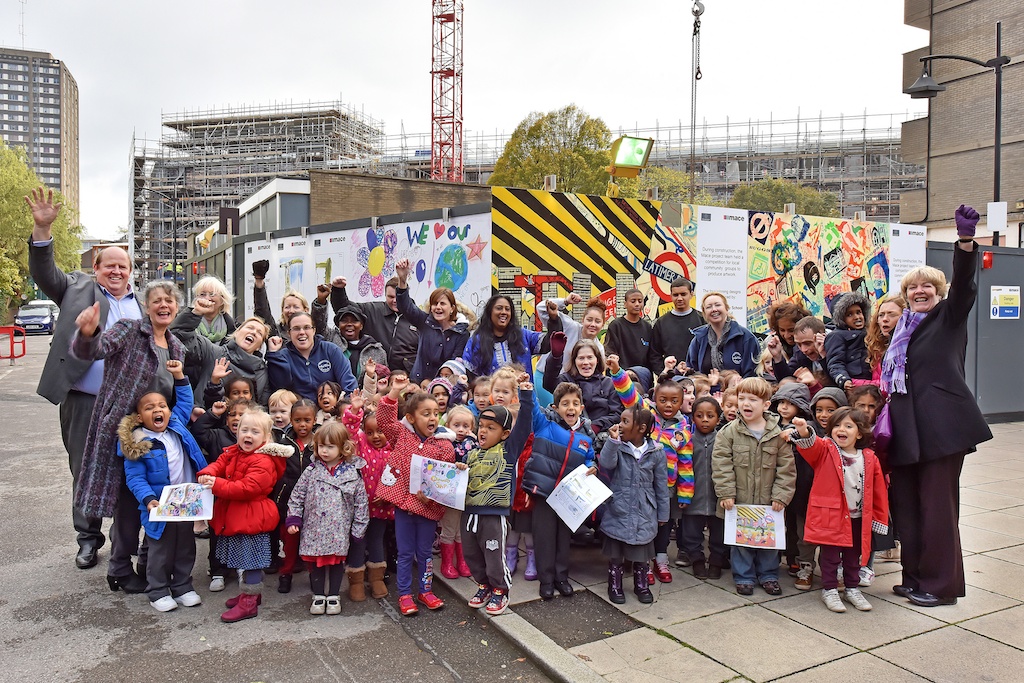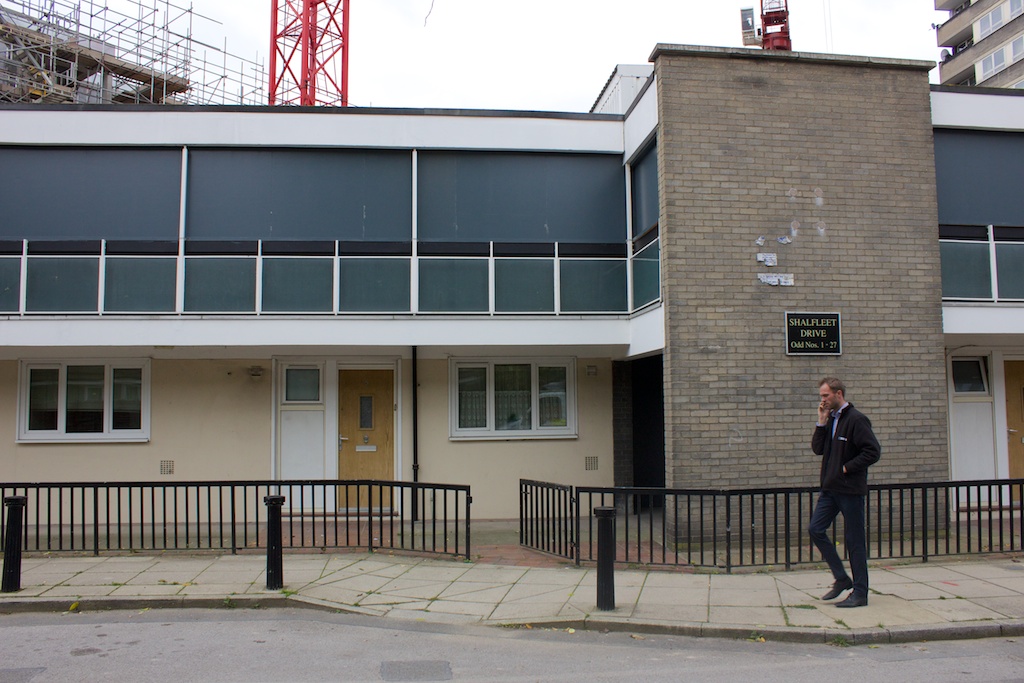|
I returned to Nursery for a week. No ordinary nursery as St Anne's is one of the oldest in London established in 1908. It is conveniently sited just at the end of the road where I have my community artist studio. Also chiming with the themes of my residency, the nursery is going to amalgamate next year with Avondale Park school and will move into a brand new building. The listed building they are vacating will probably be converted into flats in due course. What an experience and many thanks to all the staff and children. The 3-5 year old's were delightful and very engaging. They coped well with my ambitious programme of inter-related art: drawing, painting, playing with an architectural model, watching short films, making houses and tower blocks from paper. The emphasis was on being creative and having fun. Here are four things I learnt from the children. 1. Little hands, big hearts. In preparing material, I had not factored in the tiny hands of the children. Tearing a piece of paper was not as easy for some as I had imagined. Most did not have the motor skills to apply the requisite amount of pressure for using crayons on acetate sheets. The fact that they managed to create window displays on this material was herculean. Art can be hard work and physical. 2. We need to learn how to draw a house. I had naively assumed that the children would already be able to draw an outline of a house. As if this was somehow programmed in their DNA. No. They had to learn to connect lines that would form a wall, roof, door, windows and finally a house. This is where tracing or transparent sheets come in handy. 3. Practice makes perfect We would often start each session by returning back to basics. How to fold a paper once, twice and then open up to discover a sheet with four folds. How these could be bent in a variety of ways to create structures. Where to cut a door? The slightly more tricky way of cutting a window. Practice, almost perfect. 4. An artist has to enter the spirit and be transformed into a crane. Having built a paper house that could contain 4-5 children at once, we didn't have a door large enough for them to crawl in or out of. The logical solution was for an adult to act as human crane and lift the children in and out of the house. I look forward to returning back to St Ann's over the coming months. We will fine tune the art work. The completed cityscape will feature in my end of residency display at the V&A Museum from 6-8th February 2015. Nearly forgot to mention that the nursery children also took part in a recent unveiling of art work at the building site of More West. Over the summer, I had worked with other artists and children in producing two of the display panels. Great to see these finally in situ.
1 Comment
The entrance to the Architecture Gallery at the V&A has a classic marble staircase. It echoes to the sound of history. On the 19th and 20th November 2014, I held a film screening and paper folding workshop here. Visitors approaching the space would have heard the following sounds and voices. Fragment 1 The sound of WW2 bombing, glass shattering and the percussive dub of the Notting Hill Carnival. This reverberation in a usually quiet location caused a few raised eyebrows and the volume had to be scaled down. Fragment 2 North Kensington residents reminiscing about good and bad days, post-war poverty, multicultural experiences, poor housing and the British sense of humour. An American who lives in London and who viewed this section of the film programme commented about the shocking poverty and how in the good U.S. we never had it so bad. Fragment 3 A filmed conversation with Joanna Sutherland, project architect at More West housing development. This is where I am based as V&A Community artist. She talked about: "What we are seeing ... is the threat to communities due to the expense of living, not just in central London, but all areas of London. I think there has been a growing interest in the last ten years, if not longer, of how communities evolve and what's important within a community, whether it's through schools, a community facility, a church. And I hope that this project, Silchester and the wider area, still remains a home for those who have lived there, had children, and maybe they can continue to live in the same place." It was heartening to hear positive comments about this film from residents of the estate currently undergoing transformation. A new community is forming at More West built on the foundations of the previous slum clearance redevelopment in the 1960s. That phase of development was very disruptive coupled as it was with the building of the adjacent Westway A40. It did however create social housing. Today, there is no longer a desire to match that social vision, and what is affordable in terms of rent and quality of life, is beyond the means of many. The Royal Borough of Kensington and Chelsea and Peabody are providing part social and market housing at More West that consists of 45 rented homes, 39 shared-ownership and 28 for outright sale. The new housing is part of a rapidly changing area. However as our local councillor states: "There are too many poor people." Councillor Judith Blakeman has to deal with many of their social problems. Fragment 4 Glockenspiel and assorted drum kits provide a positive vision of the future. Children from Frinstead House are drawing. A girl illustrates herself waving goodbye to her father from the 20th floor of the high rise; he is waiting for his train at Latimer Road tube station. Another child mischievously draws a giant t-rex attacking the tube station. This is regeneration, disaster monster movie style. Yet another child provides a rainbow arcing across the skyline. This was one of my most direct and rewarding engagements as community artist. I did not advertise this. I merely set up a large sheet of paper in the foyer of Frinstead House and invited local residents to accompany me in filling the blank. Adults and children confirmed their cultural identity and what it means to live in their high rise homes. Fragment 5 - Was not heard at the museum. It has not been caught on camera or in any of my expressionistic documentary work. I hope to render this shortly. Symbolised by a DJ playing at a recent marketing event for More West. He has bought a flat and will move to the area in 2015. He is excited. Young and professional. For him there is no lingering doubts. He is forging the future in progressive sound waves. Zeitgeist. In summary, this curated programme had the aim of dialectical montage, the juxtaposition of contrasting images and sounds. This is our experience in all its complicated social modes. It is both beautiful and ugly. We build for the future and paper over the cracks. Speaking of paper (workshop), I have also provided a visual record of how young and old came together at the V&A Museum. Complete strangers who with a little encouragement and artistic structure are able to express light and shade, twisting new shapes into being and creating another fragment (like no 4 above) that brings a smile to my face.
Home Sweet Home
A curated programme of short films about post-war housing and regeneration. Collectively they form a framework for thinking about the housing crisis (not enough, too expensive) and the challenge of providing more homes and maintaining diverse communities. The programme running time is 1 hour. Full Circle Extract , 7.14 minutes, 1974 Animated film which looks at the the development of city living and the possibility of over-population in the future leading to the collapse of civilised life. Art and animation by Charles Goetz. Produced by Wellcome Library. Silchester Estate Medley 1 1.22 minutes Extracts from Development of the English Town 1942, British Council Film Collection. Photos and maps from London Metropolitan Archive. Radio London, Big L Theme Stereo Mix from an offshore pirate radio stations of the 1960's. Community Audio Archives. TV Licence, Columbo 15 seconds, National Archives Public Information Films Home 5:15 mins, 2012 Elegiac exploration of the last house demolished for the Westway (A40). Directed by Constantine Gras. Silchester Estate Medley 2 View from Frinstead House at Silchester Estate 1:03 secs, Photos by resident Nahib. Music by Ewa Sikorski Silchester Estate Medley 3 Residents of Frinstead House Dream of t-rex and rainbows 38 secs, drawing event, 1st October 2014 Music by Ewa Sikorski The Latymer Triangle 9:09 mins, 2013 Directed by Dee Harding. Portrait of Constantine Gras as he reflects on the complex social history of W10 in relation to his art practice. 1971 Census 60 sec, 1971, National Archives Public Information Films Feel the Groove 2.22 mins, 2014 Site specific event staged by the V&A Community Artist at 7 Shalfleet Drive on the Silchester Estate. A community celebration of musical memories and vinyl records. Nursery 11.02 mins, 2013 Directed by Constantine Gras. Portrait of a nursery on the Silchester Estate that has closed down and is temporarily handed over to artists. This is currently being regenerated into More West. Ivory Snow and Pledge Adverts, 1960s. Reproduced from John W. Hartman Centre for Sales, Advertising and Marketing History, David M. Rubenstein Rare Book and Manuscript Library, Duke University Gloucester Court Reminiscence Group. 8:52 mins, 2014 Residents discuss their diverse experience of housing, living on estates and regeneration issues. Silchester More West 8:57 mins, 2014 Conversation with Joanna Sutherland, Associate Director at Haworth Tompkins, who discusses the design, building and community that is forming at a new Peabody housing development in North Kensington. Programme curated by Constantine Gras, V&A Museum Community Artist in Residence. I am based in a 1960s council flat on the Silchester Estate in North Kensington. This is currently being redeveloped as Silchester More West and will provide 112 flats of mixed market and social rent. Films and images kindly sourced from: British Council, London Metropolitan Archives, National Archives Public Information Films, RBKC Local Studies and Archive, Wellcome Collection, Ad* access Digital Collection, D'Arcy Macius Benton & Bowles Records, John W. Hartman Centre for Sales, Advertising and Marketing History, David M. Rubenstein Rare Book and Manuscript Library, Duke University, Nahid Ashby, Gloucester Court Reminiscence Group, residents of Silchester Estate and Dee Harding. |
Categories
All
Archives
May 2024
|






 RSS Feed
RSS Feed
